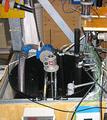Department Process Engineering
Application of powder activated carbon (PAC) to remove micropollutants from municipal wastewater
In recent years are Micropollutants (MP) more and more seen as a threat for aquatic ecosystems. Within the scope of the „MicroPoll project“ an ozonation step is applied at a full scale WWTP to oxidize the contained MP in the effluent (pilot study Regensdorf).
An alternative way to reduce the amount of MP in wastewater is a subsequent treatment of the wastewater effluent with Powder Activated Carbon (PAC). Although this method has already been successfully tested, there is still a lack of operational experience concerning full scale municipal WWTP in Switzerland. This research project aims to provide information about the design and dimensioning of plants for wastewater treatment with PAC. The research work shall allow to evaluate the process for state of the art municipal WWTP in Switzerland.
The project is focussing on a subsequent treatment of the wastewater effluent with PAC. During the treatment process most of the MP are adsorbed on the PAK and are thereby withdrawn from the wastewater.
Precondition for a large-scale application of this technique is an effective retention of the dosed PAC in order to prevent loss to the receiving Waters.
The project is subdivided into 3 Phases:
Phase 1 (January 2008 - April 2009): Treating the effluent of an existing conventional activated sludge WWTP.
At a first step a simple pilot plant is put into operation, with the goal to treat biological cleaned effluent with PAC single stage. The dosed PAC remains in the reactor for several days, whereas the water has a much lower hydraulic retention time in the range of hours. Besides obtaining information about general operating conditions regarding the dosage of PAC and flocculation agents, the operation of this pilot shall also allow to characterize the kinetics and the capacity of the adsorption process as well as the influence of the mean residence time of PAC in the reactor (sludge age). Additional batch experiments have the goal to obtain sorption isotherms and the kinetics of sorption as well as the influence of the dissolved organic carbon (DOC) and flocculant on MP sorption.

PAC-adsorption reactor for a subsequent treatment of biologically cleaned wastewater
Phase 2: (May 09 - November 09): Application of PAC in an adsorption reactor without and with recirculation of the PAC containing excess sludge in a conventional activated sludge (CAS) treatment plant.
Based on the operational experience of phase 1 a new plant is built, containing two conventional lanes operating in a continuous mode. Both the in phase 1 used adsorption reactor and an additional filter (cloth filter) are attached to one of the streets, in order to analyse the effectiveness of the PAC retention. The second street serves as a reference.
First the MP elimination performance of the adsorption reactor is tested without PAC recirculation into the biology. Different PAC concentrations are used for these experiments. Subsequently comparable measuring campaign are conducted with PAC recirculation into the biology (counter flow), to use the adsorption capacity of the PAC more effectively.
Furthermore the MP-elimination is tested in batch experiments using wastewater of different WWTP. The goal of these experiments is to further elucidate the role of the DOC in the wastewater, because it is competing with the MP for free sorption capacity on the PAC. The amount of DOC In the effluent depends among other things on the degree of purification of the WWTP (sludge age) and the temporal variation of inflowing organic compounds.
Phase 3: (December2009 - June 2010): Dosage of unloaded PAC directly into the biological step - behaviour of the loaded PAC during the sludge treatment.
Goal of this Phase is to characterize the interaction between biomass and PAC. The operation mode in 2 lanes shall provide more information about a possible inhibition of the nitrifiers caused by the dosage of PAC respectively a reduction of the adsorption capacity of the dosed PAC s
Experiments are conducted to study the behaviour of the loaded PAC in the digestion step and in the subsequent steps of sewage sludge disposal. Key issue is the question of a possible desorption of the adsorbed MP or the influence of PAC on subsequent treatment processes. The possible resolution of MP shall be tested with batch experiments e.g. with sludge digestion water.
Since the introduced project has strong thematic links to the project „PAC dosage to flocculation filtration of WWTP Kloten/Opfikon to improve micropollutant removal“, the research work is tightly coordinated between these two Projects.
